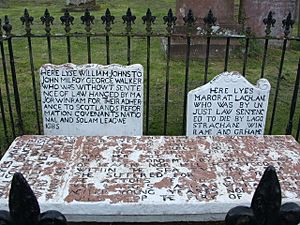Wigtown Martyrs facts for kids
The Wigtown Martyrs were two brave Scottish women, Margaret Maclauchlan and Margaret Wilson. They lived a long time ago, in 1685, and were part of a group called the Scottish Covenanters. These Covenanters believed strongly in their own way of worship, which was different from the king's church at the time, the Episcopalian Church. Because of their beliefs, Margaret Maclauchlan and Margaret Wilson were sadly executed in Wigtown, Scotland. They were tied to stakes on the muddy ground as the tide came in, and they drowned.
Who Were the Wigtown Martyrs?
The Wigtown Martyrs were Margaret Maclauchlan, an older woman around 63 years old, and Margaret Wilson, a young woman about 18 years old. They were Covenanters, a group in Scotland who wanted to practice their religion freely. During a tough time known as the "Killing Times" in the 17th century, many Covenanters faced harsh treatment.
Their Story
Margaret Maclauchlan and Margaret Wilson were arrested because they were Covenanters. They were held in prison for about a month. Then, they were accused of being rebels, meaning they did not follow the king's rules about religion. They were sentenced to death by drowning.
The Execution
On May 11, 1685, the two women were taken to the tidal channel of the River Bladnoch, near Wigtown Bay. They were tied to stakes in the mud. The plan was to tie the older woman, Margaret Maclauchlan, closer to the water. The people carrying out the execution hoped that Margaret Wilson, the younger woman, would watch her drown and then change her mind about her beliefs.
But Margaret Wilson was very brave. She did not change her mind. Both women died as the tide rose and covered them. This sad event was carried out by soldiers led by Major Windram. Sir Robert Grierson of Lag, who had the king's permission to stop Covenanter activities, was also there.
Remembering Their Sacrifice
The story of the Wigtown Martyrs became well-known. A man named Robert Wodrow collected many stories of Covenanters who suffered for their beliefs. He wrote about Margaret Maclauchlan and Margaret Wilson in his book, History of the Sufferings of the Church of Scotland from the Restoration to the Revolution.
Today, there are special places in Wigtown that remember these two women.
- There are two graves for them in the local churchyard.
- On a nearby place called Windy Hill, there is a tall memorial stone called an obelisk.
- There is also a stone marker at the exact spot where they died by the water.
These memorials help people remember the bravery of the Wigtown Martyrs and their strong faith.


